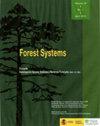热处理对加拿大杨I-214木材硬度、密度和色泽的影响
IF 0.7
4区 农林科学
Q3 FORESTRY
引用次数: 2
摘要
研究目的:评价热处理对杨材硬度、密度和色泽的影响。研究区域:来自阿根廷内格罗波莫纳的15年树龄杨树。材料和方法:352个样品暴露于不同的HT方案:120ºC、160ºC、180ºC和200°C,持续45分钟、90分钟、135分钟和180分钟。在每次HT组合前后测定硬度、密度和颜色。硬度和密度测试按照IRAM标准的规范进行,木材颜色根据CIELab系统确定。主要结果:与对照组相比,在160°C下45分钟和90分钟的硬度显著提高(分别为14.34%和9.08%),而在120°C下,所有情况下硬度都有所提高,没有显著差异。200°C:45分钟的时间表显示出最差的性能,硬度损失为20.26%。在所有方案中,密度都低于对照,损失范围从2.50%到10.00%。随着HT强度的增加(主要是温度),颜色变得更暗(L值降低,a和b值增加),在180°C和200°C时变化变得明显。研究重点:加拿大P.X‘I-214’的高温处理在两种高温处理方案下提高了其硬度,尽管不足以扩大其可行的应用范围,因为它仍然属于“软”木材的一类。硬度和密度之间没有明显的相关性,杨木的颜色随着HT强度的增加而变暗。本文章由计算机程序翻译,如有差异,请以英文原文为准。
Effect of heat treatment on hardness, density and color of Populus × canadensis ‘I-214’ wood
Aim of study: To evaluate the effect of heat treatment (HT) on hardness, density and color of Populus × canadensis ´I-214´ (poplar) wood.
Area of study: 15-years-old poplar wood from Pomona, Río Negro, Argentina.
Material and methods: 352 samples were exposed to different HT schedules: 120ºC, 160ºC, 180ºC and 200°C for 45 min, 90 min, 135 min and 180 min. Hardness, density and color were determined before and after each HT combination. Hardness and density tests were performed following the specifications of IRAM standards and wood color was determined according to CIELab system.
Main results: Hardness improved significantly at 160°C for 45 min and 90 min in comparison with control (14.34% and 9.08%, respectively) whereas this property was improved at 120°C in all cases without significant differences. The 200°C: 45 min schedule showed the worst performance with a 20.26% hardness loss. Density was lower than the control in all schedules with losses ranging from 2.50% to 10.00%. Color became darker (decrease in L value, increase in a and b values) as HT intensity increased (mainly temperature), with changes becoming evident at 180°C and 200°C.
Research highlights: HT on P. × canadensis ‘I-214’ improved its hardness under two HT schedules, although was not enough to extend the feasible applications, since it still belongs to a category of “soft” wood. Hardness and density did not show a clear correlation and color of poplar wood became darker as HT intensity increased.
求助全文
通过发布文献求助,成功后即可免费获取论文全文。
去求助
来源期刊

Forest Systems
FORESTRY-
CiteScore
1.40
自引率
14.30%
发文量
30
审稿时长
6-12 weeks
期刊介绍:
Forest Systems is an international peer-reviewed journal. The main aim of Forest Systems is to integrate multidisciplinary research with forest management in complex systems with different social and ecological background
 求助内容:
求助内容: 应助结果提醒方式:
应助结果提醒方式:


